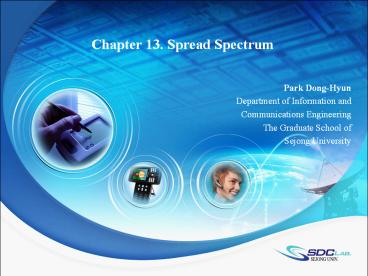Chapter 13. Spread Spectrum PowerPoint PPT Presentation
1 / 27
Title: Chapter 13. Spread Spectrum
1
Chapter 13. Spread Spectrum
- Park Dong-Hyun
- Department of Information and
- Communications Engineering
- The Graduate School of
- Sejong University
2
Contents
- Spread Spectrum Principles
- Direct Sequence Spread Spectrum (DSSS)
- DSSS System Model
- Spreading Codes for ISI Rejection
- Synchronization
- Rake receivers
- Frequency-Hopping Spread Spectrum
- Multiuser System
3
Spread Spectrum Principles (1)
- The signal occupies a bandwidth much larger than
is needed for the information signal. - The spread spectrum modulation is done using a
spreading code, which is independent of the data
in the signal - Despreading at the receiver is done by
correlating the received signal with a
synchronized copy of the spreading code. - Developed initially for military application
- Types
- Frequency hopping
- Direct sequence
- Basis for CDMA(Code Division Multiple Access)
4
Spread Spectrum Principles (2)
- Input fed into channel encoder
- Produces narrow bandwidth analog signal around
central frequency - Signal modulated using sequence of digits
- Spreading code/sequence
- Typically generated by pseudonoise/pseudorandom
number generator - Increases bandwidth significantly
- Spreads spectrum
- Receiver uses same sequence to demodulate signal
- Demodulated signal fed into channel decoder
5
Spread Spectrum Principles (3)
- Spread Spectrum advantages
- Anti-jamming
- Interference Rejection
- Message Security Privacy
- Low Probability of Intercept
- Rake receivers
6
Spread Spectrum Principles (4)
- Frequency Hopping Spread Spectrum
- To combat frequency-selective fading
- To combat narrow-band interference
- To protect against intentional jamming and
hostile surveillance
7
DSSS System Model (1)
- Each bit in the original signal is represented by
multiple bits(chip code) in the transmitted
signal - The chipping code spreads the signal across a
wider frequency band in direct proportion to the
number of bits used
8
DSSS System Model (2)
9
DSSS System Model (3)
- Message Data (random binary wave)
- bit period (sec) Tb
- bit rate (bps)
- Power spectral density
- Spreading Code
- chip period (sec) Tc
- chip rate (cps)
- Power spectral density
10
DSSS System Model (4)
11
DSSS System Model (5)
12
Spreading Code property
- Randomness property
- Balance property
- Have an equal number of ones and zeros.
- Run property
- ?? run length(?? type? digit sequence)?
- half length 1,
- 1/4 length 2,
- 1/8 length 3.
- Correlation property
- Random sequence? shift ??? ?? sequence? ????
(modulo-2), agreement? disagreement? ??? ??? 1???
???.
13
Synchronization
- The Synchronizer
- Must align the timing of the spreading code
generator in the receiver with the spreading code
associated with one of the multipath components
arriving over the channel. - Feedback control loop
- Adjust the delay of the spreading code
generator until the function reaches
its peak value. - Coarse Synchronizer (Acquisition)
- is within a chip time of perfect
- synchronization.
- Fine Synchronization (tracking)
14
RAKE receivers
- IS-95 transmitter ??? ??
- Qualcom patent
- Multipath ??? multipath diversity
- ? path??? ?? signal? ?? decoding (demodulation -gt
despreading) ? ?, attenuation factor? ??? ??. - gt ? ? signal strength? ?? ? ??.
15
Frequency-Hopping Spread Spectrum(FHSS) (1)
- Rapidly change the transmission frequency
- Pseudorandom pattern in a predetermined (Fig.
11.1) - Timing the hops accurately is the key to success
- Synchronization between transmitter and receiver
- Frequency allocation
- FDMA Fixed allocation
- FH time dependent
16
Frequency-Hopping Spread Spectrum(FHSS) (2)
- Avoid interference with primary users
- Primary users are assigned narrow frequency bands
- Transmit at a power high enough to override the
WLAN - Any interference caused by the secondary user
- Affect the primary user is transient
- Because the hopping sequence spreads the energy
out over a wide band - Primary user only looks like transient noise
Fig. 11-2. Avoiding interference with frequency
hopping
17
Frequency-Hopping Spread Spectrum(FHSS) (3)
- Two FH system need to share same band
- Configure with different hopping sequences
- Do not interfere with each other
- During each time slot
- Two hopping sequences must be on different
frequency slots - Orthogonal hopping sequence
- EXgtFigure 11-3
- Sequence 1 2, 8, 4, 7
- Sequence 2 6, 3, 7, 2
Fig. 11-3. Orthogonal hopping sequences
18
Multiuser DSSS (ex.CDMA)
- Pilot channel
- Unmodulated Direct Sequence Spread Spectrum ??
- ?Cell? ?? Cell? ??
- ?? channel? coherent demodulation? ?? reference
?? - Sync channel
- -1200 bps data rate
- ???? ????? ??? ?? ????
- Paging channel
- 4800 or 9600 bps flexible data rate
- ???parameter, access parameter?? ????
- Page ????? ?? ??
- Traffic channel
- 1200, 2400, 4800, or 9600 bps variable rate
vocoding - ????? ???? call processing? ?? channel
19
Multiuser DSSS (ex.CDMA)
- CDMA Forward Link
20
Multiuser DSSS (ex.CDMA)
- Forward Link Channel Signaling
21
Multiuser DSSS (ex.CDMA)
22
Multiuser DSSS (ex.CDMA)
23
Walsh Covering/Modulation
- Walsh Function
24
64-ary Walsh Function
25
Multiuser DSSS
- Reverse Link
26
Multiuser DSSS (ex.CDMA)
- Reverse Link
Fig. DSSS uplink system
27
Q A
- Thank you for giving your attention!
- ?
- ?

